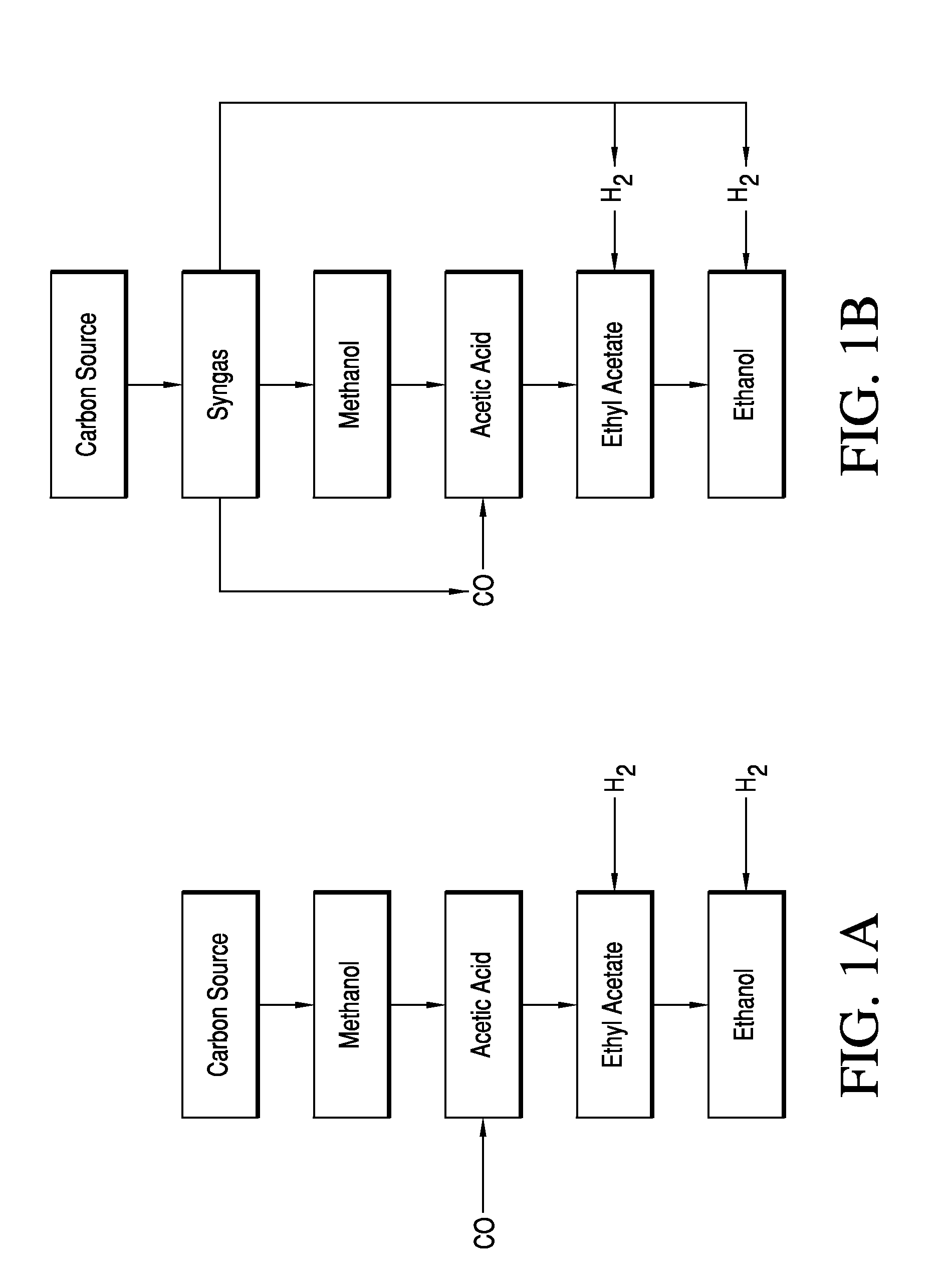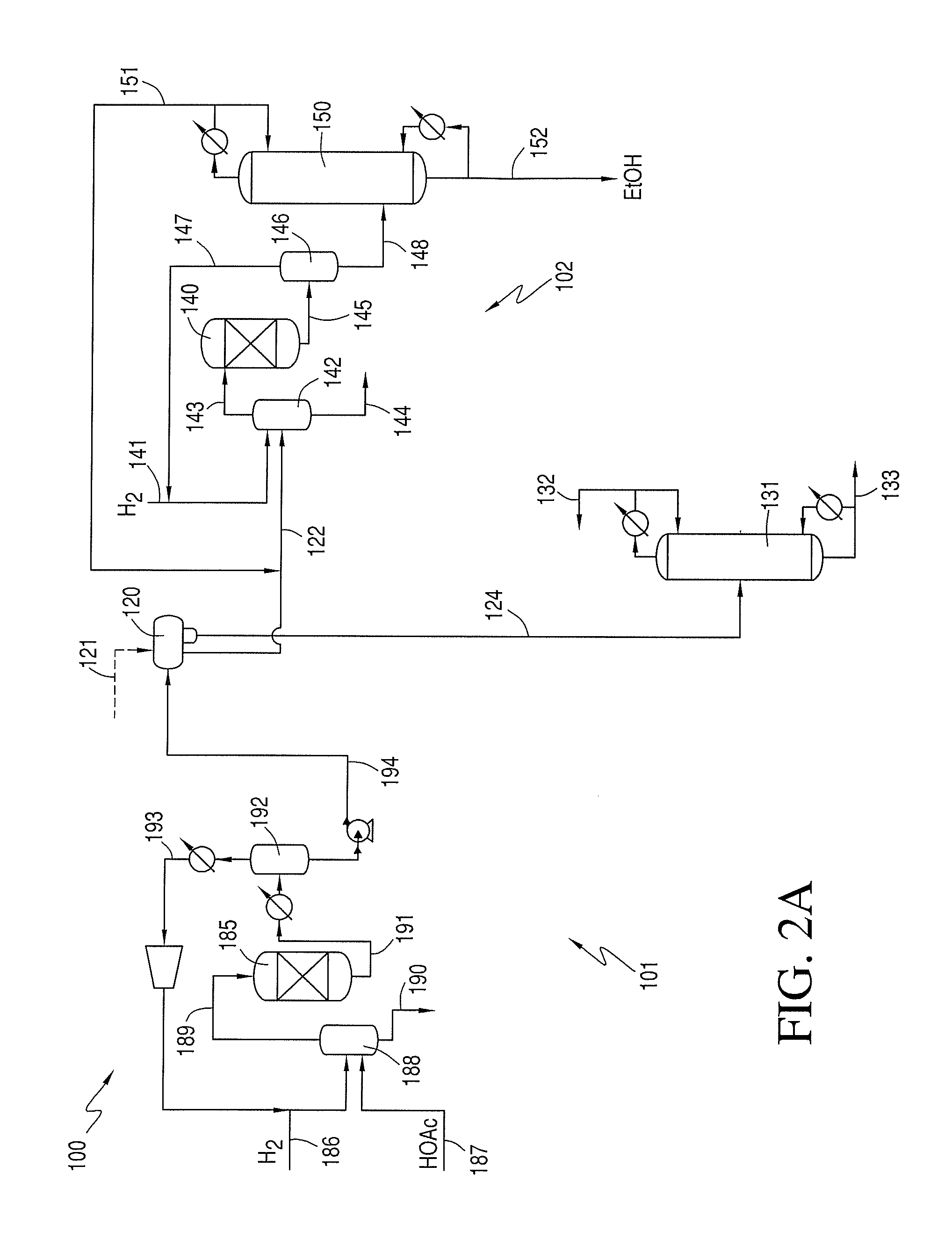Phasing Reactor Product from Hydrogenating Acetic Acid Into Ethyl Acetate Feed to Produce Ethanol
a technology of ethyl acetate and reactor product, which is applied in the direction of organic chemistry, chemistry apparatus and processes, and preparation of oxygen-containing compounds, can solve the problems of significant amounts of by-products, methane, ethane, etc., and achieve the effect of reducing the amount of diethyl acetal
- Summary
- Abstract
- Description
- Claims
- Application Information
AI Technical Summary
Benefits of technology
Problems solved by technology
Method used
Image
Examples
example 1
Hydrogenolysis Catalyst
[0213]The hydrogenolysis was carried out in a vapor-phase, heterogeneously catalyzed, continuously stirred tank (Berty type) reactor. The catalyst was T-2130™ (Süd Chemie), which has the following composition: CuO (26%), ZnO (53%). The hydrogenolysis catalyst was reduced at an operating pressure of 690 kPa with an initial temperature of 120° C. that was increased to 170° C. while introducing a low flow rate of hydrogen gas into a constant inert gas feed stream to the reactor to achieve a hydrogen concentration of 0.5-1.0% H2. The H2 concentration was slowly increased stepwise to 2.2%, 3.5%, 4.0%, 5.0% and 6.0% and then was held at a constant reactor temperature of 215° C.
[0214]A mixture of H2 (93.6 mol %), N2 (2.5 mol %), and ethyl acetate (3.9 mol %) was passed over 52.9 g T-2130™ catalyst at 260° C., with a pressure of 4140 kPa and GHSV of 6000 hr−1. The LHSV was 1.0 hr−1. The observed conversion of ethyl acetate was 86.4% with a selectivity to ethanol of 92...
example 2
Hydrogenolysis Catalyst
[0215]Operating under the same conditions as Example 1, a mixture of H2 (84.5 mol %), N2 (9.0 mol %), and ethyl acetate (6.5 mol %) was passed over 52.9 g T-2130™ at 240° C., with a pressure of 4140 kPa, GHSV of 1700 hr−1, and LHSV at 0.47 hr−1. The observed conversion of ethyl acetate was 87.8% and the selectivity to ethanol was 96.4%. The observed productivity of ethanol (g EtOH / kg catalyst / hr) was 290 g EtOH / kg catalyst / hr.
example 3
Hydrogenolysis Catalyst
[0216]MegaMax700™ (Süd Chemie), which has the following composition: CuO (61%), ZnO (28%), Al2O3 (10%) was used in place of the T-2130™ catalyst in Example 1. The operating conditions were similar as to Example 1. A mixture of H2 (92.0 mol %), N2 (2.7 mol %), and ethyl acetate (5.3 mol %) was passed over 38.72 g MegaMax700™ at 250° C. at an operating pressure of 2410 kPa, a GHSV of 5460 hr−1, and a LHSV of 1.3 hr−1. The observed conversion of ethyl acetate was 80.1% and the selectivity to ethanol was 85.1%. The observed productivity of ethanol (g EtOH / kg catalyst / hr) was 848 g EtOH / kg catalyst / hr.
PUM
| Property | Measurement | Unit |
|---|---|---|
| Temperature | aaaaa | aaaaa |
| Temperature | aaaaa | aaaaa |
| Fraction | aaaaa | aaaaa |
Abstract
Description
Claims
Application Information
 Login to View More
Login to View More - R&D
- Intellectual Property
- Life Sciences
- Materials
- Tech Scout
- Unparalleled Data Quality
- Higher Quality Content
- 60% Fewer Hallucinations
Browse by: Latest US Patents, China's latest patents, Technical Efficacy Thesaurus, Application Domain, Technology Topic, Popular Technical Reports.
© 2025 PatSnap. All rights reserved.Legal|Privacy policy|Modern Slavery Act Transparency Statement|Sitemap|About US| Contact US: help@patsnap.com



